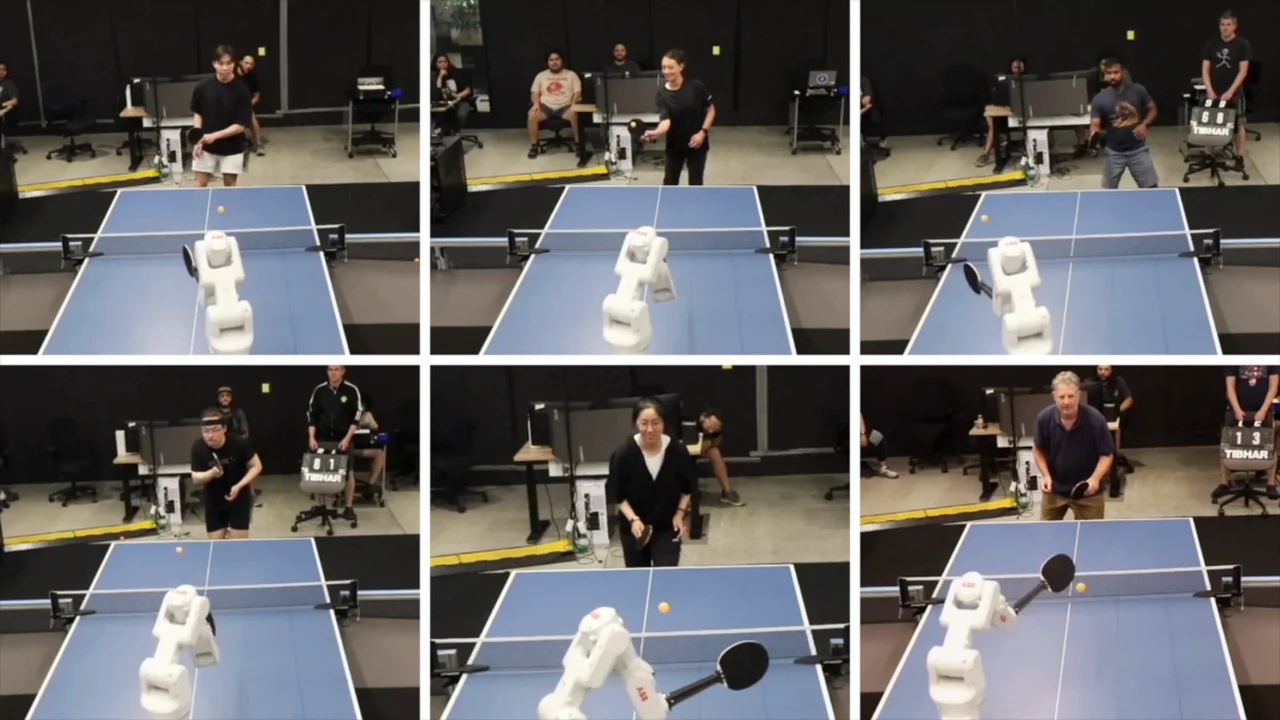Google DeepMind has developed a robotic system capable of achieving amateur human-level performance in table tennis. This breakthrough highlights advancements in transferring skills learned in simulations to real-world applications, a process known as “Sim-to-Real.” The robot was trained using a combination of simulation and real-world interactions, focusing on cooperative play rather than merely winning. The project utilized an open-source physics simulator, MuJoCo, to develop and refine the robot’s skills.
Google DeepMind AI
- Google DeepMind developed a robotic system that plays table tennis at an amateur human level.
- The project demonstrates significant progress in “Sim-to-Real” skill transfer.
- The robot was trained using both simulations and real-world interactions, focusing on cooperative play.
- MuJoCo, an open-source physics simulator, was used to develop the robot’s abilities.
- The robot can engage in rallies, respond to spins, and adapt to the opponent’s style.
- Sim-to-Real transfer is complex but effective in training robots for real-world applications.
- Initial lack of data on robot-human interactions posed a training challenge.
- Mastering core skills like forehand and backhand rallies was essential.
- The training process was iterative, alternating between simulation and real-world fine-tuning.
- Ensuring the robot was enjoyable and engaging for human players was a key focus.
- MuJoCo’s open-source nature allows for further advancements in robotic training.
- User feedback was crucial in refining the robot’s performance and ensuring it was enjoyable to play against.
- The project’s success has broader implications for robotic training and skill transfer in various fields.
The robotic table tennis player was developed through a combination of simulation-based training and real-world interactions. Notably, the focus was on allowing the robot to engage in cooperative play with human partners, rather than simply aiming to win at all costs. By using the open-source physics simulator MuJoCo, the DeepMind team was able to create realistic simulations to train and refine the robot’s skills before testing them in the physical world.
Table tennis presents significant challenges for a robot, requiring quick reflexes, precise movements, and the ability to adapt to the opponent’s playing style. To achieve amateur human-level performance, Google DeepMind’s robotic system needed to:
- Engage in sustained rallies
- Handle various types of spin on the ball
- Maintain a consistent level of play comparable to an amateur human
This involved developing a deep understanding of the game’s nuances and the ability to continuously adapt to the human player’s actions.
Table Tennis Robot
Here are a selection of other articles from our extensive library of content you may find of interest on the subject of robotics :
Overcoming the Challenges of Sim-to-Real Transfer
Transferring skills learned in simulation to the real world is a notoriously difficult problem in robotics. The success of Google DeepMind’s robotic table tennis player in bridging this gap demonstrates the effectiveness of their approach, which involved:
- Extensive simulation-based training to develop core skills
- Fine-tuning the robot’s performance in real-world scenarios
- An iterative training process alternating between simulation and real-world practice
One of the key challenges was the initial scarcity of data on robot-human table tennis interactions. Innovative data collection and utilization strategies were crucial in allowing the robot to quickly learn and adapt to human play.
Focusing on Human Interaction and Engagement
Beyond just creating a robot that could play table tennis, the DeepMind team aimed to develop a system that would be enjoyable and engaging for human players. This focus on human interaction guided the development process, resulting in a robot that could serve as both an effective training partner and a fun opponent.
User feedback played a vital role in refining the robot’s performance. Positive experiences reported by human players, in terms of enjoyment, engagement, and challenge, validated the robot’s effectiveness and guided further improvements.
The Potential for Broader Impact
The successful development of Google DeepMind’s robotic table tennis player has significant implications beyond the realm of sports. The techniques and technologies pioneered in this project could potentially be applied to a wide range of domains, including:
- Industrial automation
- Healthcare robotics
- Autonomous systems
By demonstrating the feasibility of training robots in simulation and transferring those skills to real-world applications, this project opens up exciting new possibilities for the future of robotics and human-robot interaction. The use of open-source tools like MuJoCo also paves the way for other researchers and developers to build upon this work, potentially accelerating progress in robotic learning and skill transfer.
Google DeepMind’s robotic table tennis player represents a significant leap forward in the field of robotics. By achieving amateur human-level performance, overcoming the challenges of Sim-to-Real transfer, and prioritizing human engagement, this project sets a new benchmark for what is possible in the realm of robotic learning and human-robot interaction. As the techniques and technologies developed here are applied to other domains, we can expect to see transformative advances in the capabilities of robotic systems and their ability to seamlessly integrate into human environments.
Image Credit: MIT
Filed Under: AI, Technology News
Latest TechMehow Deals
Disclosure: Some of our articles include affiliate links. If you buy something through one of these links, TechMehow may earn an affiliate commission. Learn about our Disclosure Policy.
